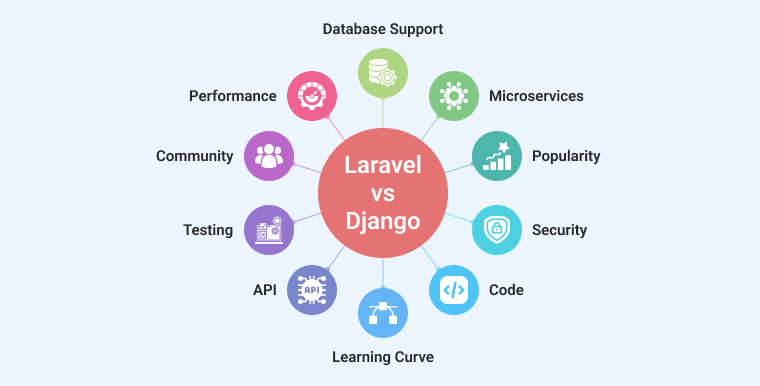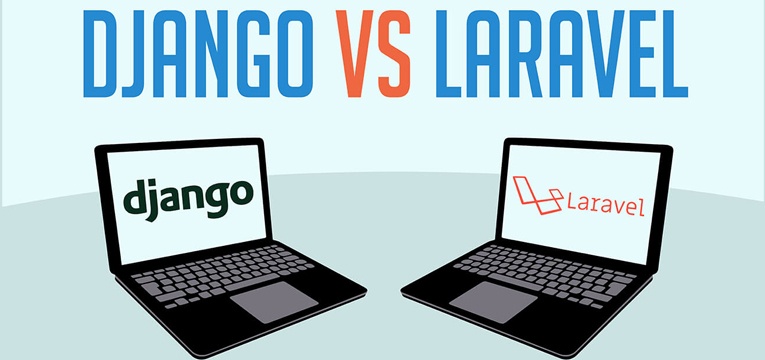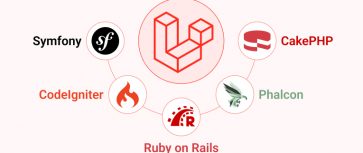Laravel vs Django – Which Backend Framework is Better for Development ?
The selection of a web framework, such as Django vs Laravel, is a critical one in web development. It may make or destroy a project, since a web app development framework acts as a core upon which your online application is built.
Two of the most popular backend web frameworks are Django and Laravel. Both provide superior features, functions, and capabilities that enable them to serve and satisfy the expectations of users across a variety of industrial verticals.
This post will attempt to resolve this dispute by comparing Django with Laravel on a variety of criteria, including simplicity of use, scalability, privacy, adaptability, database and microservices assistance, and community support. But first, let’s establish some fundamental notions about web frameworks in general, and then Django vs Laravel in particular.
1. What are Web Development Frameworks?
In simple words, web development frameworks are a set of different tools and libraries used to make things simpler and better, in short they are meant to facilitate rapid development. Take any web application development process into account, most of the Laravel developers in India consider that a web application framework is very crucial and it is a sensible approach for building rich, interactive and complex web apps.
Technically speaking, a web app consisting of server-side (backend) is what happens on the server/database and client-side (frontend) frameworks are what happens in the browser. Even though they have a fair share of differences, both of them matter a lot. . Now let us get acquainted with what they are.
1. Frontend Frameworks
React, Vue.js, Angular, Ember, backbone are to name a few when considering popular front-end frameworks for web development. Anyone who doesn’t work with such concepts might find it a bit challenging to wrap their head around. There was a time when websites with the help of HTML and CSS tended to remain in a simple and static format.
With the time passing by, frontend web development seems to have changed to a great extent – all thanks to HTML5, JavaScript, CSS, UI and UX designing, and so much more.
2. Backend Frameworks
From Express to Django, Rails, Laravel, Spring is to consider when looking for a popular backend framework. Being largely driven by JavaScript, HTML, CSS, Backend is way different from front-end development. Let’s break things down in the server-side realm:
- Languages & frameworks – A wide range of popular programming languages and web frameworks are involved in building backends for Laravel development projects.
- Web Servers – As the name implies they are mere computer programs which end up storing, preparing and conveying web pages for the end-users.
- Database Management Systems – Here backend developers can have an information base, control, decipher and speak to information.
- Testers- Almost all the software developers consider speed testers like Google PageSpeed Insights and Full-page testers as page load speed plays a very crucial role in increasing the site traffic.
It’s time to meet the most popular backend frameworks Django and Laravel; to know about their advantages and disadvantages and find out which one is more suitable for your upcoming web and mobile development project.
2. Laravel Framework

Laravel was created by Tayler Otwell in 2011. Furthermore today, it has become one of the most famous web advancement frameworks which are ideal to construct content management systems. 9GAG, Toyota Hall Of Fame, UNION are the few names which have made the most of the Laravel development technology.
1. Pros of Laravel Open Source Framework
- Learning Curve – It may interest you to know that the Laravel web development framework is very easy to learn. You know why? This is one such leading web framework where you will find a plethora of developers and Laravel development companies who can assist you when in trouble. Also, the documentation is way simpler even for the beginners to learn and get started.
- Artisan – Seamlessly developing command-line applications is now possible, all because of the Artisan CLI. For those backend web developers who have just begun their journey and don’t know anything about it; Artizan CLI incorporates a bunch of numerous advanced tools so that they can perform tasks and migrations in a hassle-free manner.
- Rich and Robust Features – Last but not the least, it always tends to remain up-to-date. This means all the latest bunch of inbuilt features can be easily found in the Laravel framework. Interfaces, Namespaces, Anonymous, functions, overloading are to name a few standalone features in Laravel 5.

2. Cons of Laravel Framework
When there is a good side, you will always find a bad side. Yes, with all these amazing looking features and functionalities, Laravel development does tend to have a fair share of controversies as well:
- The payment feature is a huge failure here! Also, there are ample security holes.
- Migration and up-gradation are not seamless; in the worst scenario, it might break your web application.
- Does it offer 100% mobile richness? A Big-fat “NO”!
3. Popular apps using Laravel as backend technology

Laracasts, an e-learning website, offers various courses and acts as a forum for professionals to address and resolve technical questions.
Barchart, a financial site, benefited from the most up-to-date international market data in shares, currency trading, trade offers, and gold price, among other categories.
Asgard CMS is a modular multilingual content management system (CMS) that includes innovative ready-to-use modules such as a dashboard, media marketing, and a configurable back-end.
World Walking, a nonprofit healthcare platform, focuses on incentivising individuals to walk more through incentive and recognition programmes.
Neighborhood Lender leverages Laravel’s backend support to act as a mortgage calculator with a wide variety of financial capabilities, simplifying and streamlining complex mortgage processes.
3. Django Framework

This one is an interesting Python programming language based framework, developed by Django software foundation and licensed by Berkeley Software Distribution. Django framework’s primary goal is to develop rapid web development. By following model-template-view architecture, designing web applications which are highly functional and aesthetically pleasing becomes easy. Much like Laravel development, Django has a high community of developers.
1. Pros of Django Framework
- Speed – Apart from being simple, the Django framework is fast enough in comparison to others. One of the most interesting aspects here is that without starting from scratch you can use a certain set of features for all django projects. Due to its fast nature, the app can be developed on time and reduce development time.
- Security – All Django developers need a secure platform to proceed with their software development task. In this case, if you happen to face issues like clickjacking, SQL injection then Django is the ultimate choice in regards to security.
- Scalability – Django is reasonable for a web advancement venture from little to enormous assets. Additionally, it is autonomous, (i.e.,) it supports cross platform structure that chips away at different stages like Mac, Linux, or PC.
2. Cons of Django Framework
- Use of routing pattern specifying its URL
- It’s too monolithic
- Components often get deployed together
3. Popular apps using Django as backend technology

Disqus, a website that hosts blog comments, currently hosts 50 million monthly comments and 17 billion monthly pageviews from 2 billion monthly unique users from 191 countries. The whole project was developed from the ground up in Django and has expanded effortlessly since its start.
Spotify distributes its massive music collection to millions of consumers worldwide while also boasting lightning-fast backend and machine learning capabilities.
Mozilla shifted all of its newest components to Python and Django in order to better handle the daily rise in traffic and API requests.
Dropbox launched a slew of new features including user history, account syncing across many devices, and numerous file-sharing options.
Instagram uses Django to scale with its ever-increasing traffic and while maintaining a simple UI/UX.
4. Django vs Laravel: Tabular Comparison
| Parameters | Django | Laravel |
| About it | Launched in the year 2005, Django was built to develop complex websites, cloud solutions and web applications. It was written in Python. | Tayler Otwell created Laravel in 2011 which incorporates a bunch of built-in features used to develop simple as well as complex websites and apps. |
| Maintained by | Well-maintained by Django software foundation. | Well-maintained by developers and community under MIT license. |
| Architecture | Built with Python, it comprises a Model-view-template pattern. | Built with PHP, it comprises a Model-view-controller pattern. |
| Scalability | Achieve Massive Horizontal Scaling | Supports high-scalability |
| Security | For enterprise-level applications, it is highly secure. | It comprises basic security features. |
| Speed | In comparison to Laravel, Django is pretty fast. | Vice-versa, Laravel is extremely slow. |
| Development | It can be a little problem while developing small websites. | Both simple and complex websites can be created using Laravel development. |
5. Laravel vs Django: Head to Head Comparison

Each framework is of a kind and Django and Laravel are no exceptions. Like we said before, routing can be a little bit problematic for Django but not for Laravel. Whereas Django, on the other hand, is highly secured when it comes to developing enterprise-level applications. Furthermore, let’s delve into a detailed comparison of Django and Laravel development considering various parameters.
1. Popularity
Without a doubt, Django is a highly popular framework. Django is the market leader in the computer and electronics, food and beverage, scientific, and reference website categories. It is the most widely used web framework in the United States, France, Spain, and Russia, among other nations. Below image shows popularity of various web development frameworks by Statista.

In comparison, Laravel is utilized in a broader range of website categories, including arts and entertainment, business and industry, Internet and telecommunications, retail, and travel. It is the most widely used web framework in Brazil, China, the United Kingdom, and 157 other countries.
2. Community
Django benefits from the vast Python community support. You can also easily discover Django fans on other platforms, including a Discord server with 3,400 members, a Telegram group with 6.08k members, and a variety of vibrant Slack channels.
PHP commands 79 % of the market for server-side web applications development. Laravel boasts a sizable community of over 46,231 active users. PHP and Laravel have a sizable community, where developers exchange Laravel podcasts, news, papers, and repositories, among other things.
3. Database Support
Django officially supports the following databases: PostgreSQL, MariaDB, MySQL, Oracle, and SQLite, and Laravel supports four different database systems: Postgres, MySQL, SQLite, and SQL. Interacting with these databases is simplified by the fluent query builder, raw SQL, and Eloquent ORM.
Only time will tell whether additional databases will support Laravel.
4. Testing
Testing is a breeze on Django, thanks to the abundance of testing tools available to streamline the test-writing process.
Given that Laravel is written in the PHP programming language, a plethora of testing tools are accessible to assure the development of a bug-free application.
By default, Laravel includes extensive testing documentation and all the tools necessary to test the application environment at several levels, including the ability to run mock tests by simulating application code and events.
5. Microservices
Django is an excellent backend platform for microservices architecture due to its quick development, built-in security features, and adaptability.
However, for the last few months, the demand for Laravel with a microservices architecture has been so high that a web developer created a framework called Lumen. It accomplishes the same business logic as Laravel but is leaner, smaller, and lighter.
6. Code
Basic routing code is written in both programming languages. Most of you guys may find Django’s code seems rather complex whereas Laravel’s code is quite intuitive. This is because in its routing process, regular expressions are being used.
7. Performance
In the year 2018, Laravel and Django were tested and Python won overwhelmingly as it was a fast language. The testing was done straight on for JSON serialization. Django performed 69k JSON reactions/second while Laravel was at a humble 8k reactions/second. So now you know exactly which one is better when it comes to performance comparison.
8. Security
With constant attacks and vulnerabilities being abused constantly, the web turns out to be a huge hostile atmosphere. Maybe this is why frameworks are created in such a way that they can take adequate measures against SQL infusions or cross site scripting attacks. Django pays close attention to security, assists developers and helps engineers with dodging the typical mistakes of web improvement and executing some security best measures. While Laravel moreover covers the fundamentals of security, it doesn’t fulfill Django’s security level. So now you know exactly why NASA uses Django and not laravel for their site.
9. API
Not all the functionalities that a back-end framework has to bring to the table might interest you, especially while building a client-rich application with a RESTful API. One of the advantages of Laravel is that it accompanies work in help for API working, as the queries return JSON as a matter of course. You’d need to utilize a library to make things work for you as Django doesn’t accompany this underlying element.
10. Learning Curve
The learning curve can be a bit mythical since it depends on the individual. For example, in the event that you are comfortable with Python’s elegant syntax to a decent measure, at that point look no further than Django. It should be developer-friendly as well as easy to learn.
While Laravel then again is said to have a steep learning curve to absorb information including devices like Laracasts and the great documentation, it ought not to be hard at all to get the right framework and ace the PHP language directly along.
6. Django vs Laravel: Which one to Choose for Backend Development?
This is it! It’s time to conclude the post by saying both Laravel development and Django are unique in their own way. And both of them tend to support big websites, which means choosing either of them, there is no wrong choice to make. Everything relies upon the software prerequisites you have and your plan. Likewise, back-end systems are very similar at their core, so it’s not all that difficult to change starting with one structure then onto the next on the off chance that you want to work with another system.
You may go ahead with Django if you desire to create dynamic and customized social networking platforms and develop cdn and cloud solutions that use machine learning for enhanced customization features or you may simply turn to Laravel if you want to create an engaging website design with engaging content and develop a sophisticated application using Laravel’s Blade Template Engine without introducing any extra components or additional expenses.
As an entrepreneur, there are times when you feel these technologies are too technical and daunting. During these scenarios, hiring a reliable Laravel development company that also offers Django services can be the wise decision to make. I hope you enjoyed reading the post! Keep watching the space for more information and updates.
More Comparison Blog Post
Laravel vs CakePHP: What to Choose for Web Development
ASP.NET vs PHP: What to Choose for Web Development
Web Application development platforms such as Angular and ReactJS are gaining momentum lately, but do they really deserve it? In this blog post we are...
 Oct 9, 2020
Oct 9, 2020 



thanks a ton! I did receive relevant information after reading this post that I was looking for, thanks for sharing such a nice article. Keep posting this type of informative content.
Both Laravel and Django are fantastic for creating modern web applications. You did an excellent job of describing the difference. Thank you so much for sharing this fabulous blog. Cheers!
Great article about Django vs Laravel. I am really liked the way you differentiated both of the frameworks. Keep sharing some good technical blogs like this. Thanks!
Nice Informative post.Got an overview about Laravel and Django.Thanks for sharing.